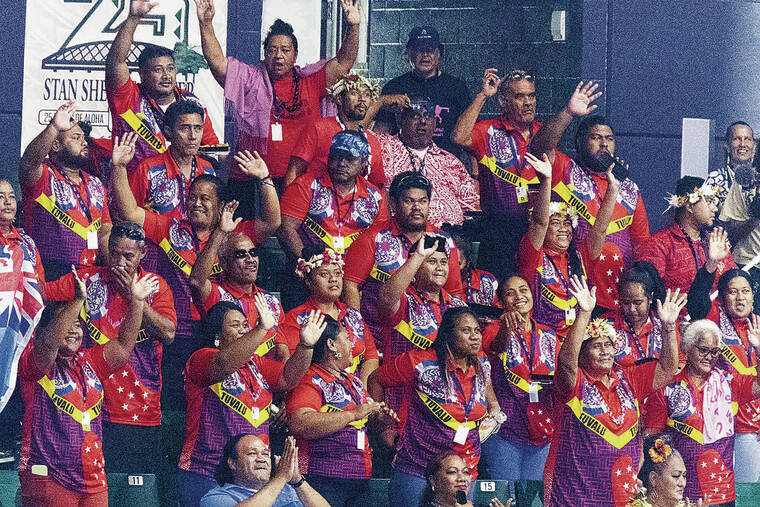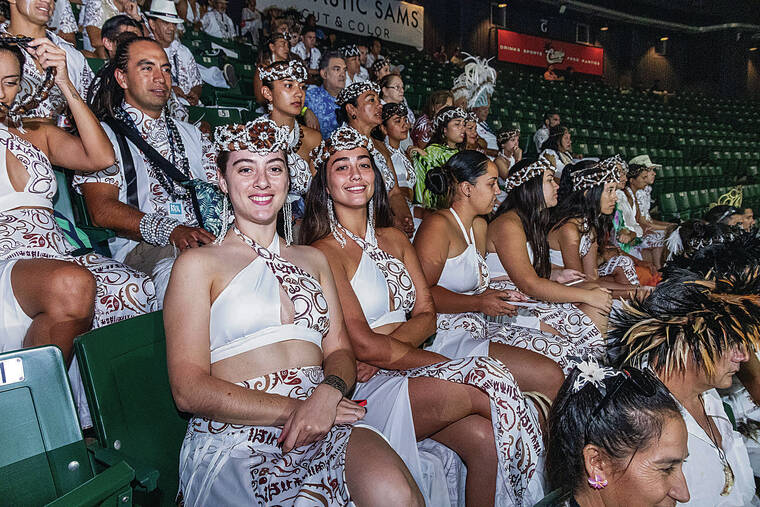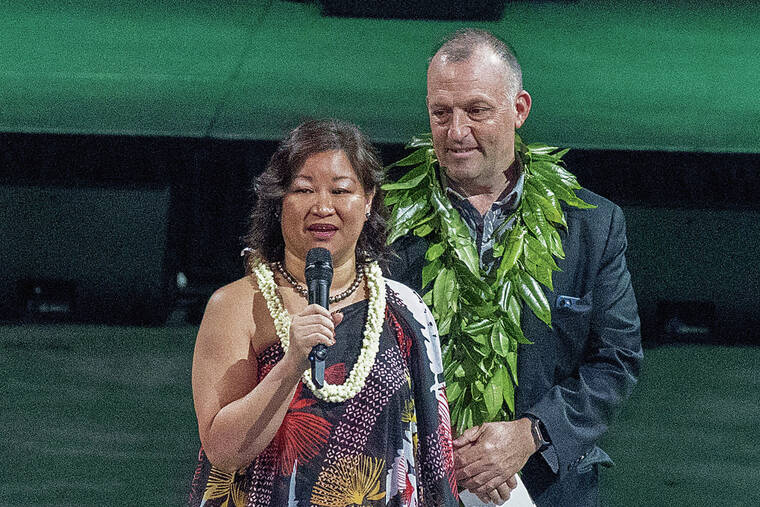The 13th Festival of Pacific Arts &Culture — the world’s largest celebration of Indigenous Pacific Islanders — concluded Sunday evening with a sold-out closing ceremony at the University of Hawaii’s SimpliFi Arena at Stan Sheriff Center, distributing all 6,500 free tickets.
Inaugurated in 1972 to halt the erosion of traditional practices through cultural exchange, the quadrennial event invited Hawaii to observe in 1976 before allowing its participation in subsequent festivals.
Kalani Ka‘ana‘ana, chair of the 13th FestPAC commission, said it was an “incredibly proud moment for Hawaii, and for us as Kanaka to host the festival.”
“This has been a long journey,” Ka‘ana‘ana said. “This is the first time we’ve been able to host and return some of the hospitality we’ve received as a traveling delegation.”
Hawaii was set to host the event in June 2020 but had to postpone due to the pandemic. Ka‘ana‘ana said the state had been preparing for this event for 12 years, if not the entire 50 years since the festival’s inception.
“We’ve seen really large attendance numbers that have exceeded our goals and expectations,” Ka‘ana‘ana said. “It’s clear that our people in Hawaii definitely showed up.”
Gov. Josh Green expected a maximum of 100,000 people moving through the Hawai‘i Convention Center over the course of the entire festival, but that number was surpassed on the first day. The state saw upward of 500,000 people at the festival over 10 days.
“So many of our local families embraced FestPAC,” Green said. “It exceeded our expectations by tenfold.”
At smaller events like Our Kakaako on June 8, Green had expected 5,000 to 7,000 people to attend, but the turnout was about 35,000.
“Besides the turnout from our local community, we also had so many more delegates than we expected,” he added.
The 13th FestPAC director, Aaron Sala, said the state had limited delegations to 100 people each, but in true “Pacific way,” nobody followed that rule and over 3,000 delegates arrived in Hawaii.
Sala expressed his tremendous appreciation for everyone who came, helping to bring Pacific Islander communities in Hawaii closer together and nurture relationships with one
another.
“We have a really large Pacific Island population living in this diaspora, and we saw the sheer joy on the faces of Pacific Islander people making Hawaii home,” Sala said. “Not all of them necessarily want to be here, so this opportunity to bring the Pacific to them is something I am profoundly grateful for.”
Tatiana Jackson, a 21-year-old student at UH Manoa from Samoa, attended the closing ceremony Sunday. Leading up to the ceremony, she participated in various events, including the Kakaako night market and activities at the Festival Village.
Jackson chose to pursue her studies in marine biology at UH to work on coral conservation back home and to run for Miss Samoa, aiming to gain a larger platform to address issues facing both Samoa and the Pacific Islands.
“Even just talking about FestPAC gets me so emotional,” she said. “It feels so much like home.”
Jackson emphasized that the Festival Village, in particular, resonated deeply with the themes of “Moananuiakea” and “Regenerating Oceania.”
She described entering the space as “stepping into another dimension; I was welcomed with the perfect representation of Pasifika shores.”
Jackson said that during her time living in Hawaii, she has experienced imposter syndrome, feeling like “a small fish in a big ocean.”
However, attending the festival reminded her that everyone is in the same boat and gave her a sense of belonging.
“Knowing that these people are here, it makes me feel whole; that’s hard to find anywhere else,” Jackson said. “It really was a bridge between the Pasifika and the Western world.”
In 2023 the state Legislature allocated $200 million in state funds to Green, granting him discretion over how to allocate and spend the money.
The initial expenditure
of $5 million for FestPAC, Green said, was an “opportunity to quickly solidify our commitment” and to overcome uncertainties about the feasibility of hosting the event.
In addition to this, the Legislature allocated an additional $5 million, bringing the total state funding for FestPAC to $10 million.
However, Green said hosting FestPAC had never posed a financial problem, as it was a responsibility to gather and celebrate people and empower all cultures, encompassing 28 Pacific
islands and territories.
He had also emphasized that FestPAC would serve as a celebratory comeback for the people of Hawaii, particularly following the devastation caused by the Aug. 8 wildfires on Maui.
The Rapa Nui delegation was acknowledged during the closing ceremony for its gesture of carving a gift for the victims of Lahaina and the people of Maui.
Tau Mana Tuki, a dancer, painter and carver from Rapa Nui, said FestPAC played a significant role in highlighting the importance of respect and solidarity within Oceania, portraying it as a cohesive and supportive extended family.
According to Tuki, FestPAC served as a catalyst for fostering new relationships and appreciation for other cultures. The festival also was a significant motivation for him to enhance his skills as an artist.
He hopes to work harder to foster and express his culture while also evolving creatively to preserve old traditions for future generations.
Regarding environmental stewardship, Tuki emphasized the importance for young people, including himself and those younger, to take an active role in caring for the land.
“Sometimes it feels unfair that older generations bear all the responsibility for preserving cultures and traditions,” the 21-year-old said. “We should empower younger generations to take ownership and showcase our cultures, as they will be the ones leading in the future.”
During his first visit to Hawaii, Tuki described it as a “beautiful aina with beautiful people.”
He appreciated that FestPAC was hosted in a setting that combines natural beauty, like his home, with urban elements.
Being in a city environment inspired him to introduce his culture to those who may not be familiar with it.
“The bonds that have been formed between nations were powerfully visible, with nations embracing each other,” Green said. “There was no conflict.”
In addition to cultural bonds, Green highlighted that political bonds also emerged through FestPAC.
U.S. Deputy Secretary of State Kurt Campbell attended the June 7 FestPAC event to facilitate new sister-city relationships between Honolulu and Avarua of the Cook Islands. Green also emphasized that Washington, D.C., recognized Hawaii’s significant role within the context of Pacific nations.
Looking ahead, Green
expressed his intention to follow up on FestPAC by hosting smaller delegations — three or four at a time — for bilateral and multilateral communications to deepen engagement within the Pacific region to support the needs of this “extended family.”
“There were moments where we didn’t know whether or not our commitment was robust enough to host a festival of this magnitude,” he said.
Green said millions of
dollars in revenue flowed between nations without hesitation; the bigger picture lies within the state’s commitment to forming strong bonds with Pacific nations.
“We feel that they should be embraced, be free nations and supported by the U.S. when they ask,” he said. “We feel that any nation that is wrestling with climate change or is vulnerable because they can’t survive without some extra support, we want to be there as family.”
“As an American governor I want to be supportive of that.”
During Green’s speech at the closing ceremony, there were several people engaged in political protests advocating for the freedom of West Papua and the Palestinian territories.
Jackson, who supports these movements, acknowledged the importance of bringing attention to such issues but expressed that it should have been done at the appropriate time and place.
“In a setting where we are bidding farewell, where it’s a sendoff of our ohana, it’s important for us to maintain this place of aloha and use our powers in a manner that does not create tension,” she said.
Ka‘ana‘ana said the power of the festival was to provide a platform and be a catalyst for connection.
While there were challenges faced throughout the festival, including the complexities of the festival, Ka‘ana‘ana said the festival was overall a success that has brought “incredibly enriching experiences for so many of us.”
Ka‘ana‘ana said a personal challenge he faced was “navigating two worlds at once.”
“As the legislatively
created and government-
created commission for the festival, I have responsibilities to ensure that the funds were spent appropriately,” he said. “But also walking with another foot in the cultural world, with the cultural protocols and processes, there were certain ways that it had to be done.”
“This was a really great learning experience for me to sort of have to walk in two worlds at the same time.”
He said it was most significant to kick off the festival with the waa arrival ceremony on June 5, “paying respect to those ancestors who braved our ocean and populated our islands,” and to continue the next day with an official opening ceremony that fit into the Western context, beginning with a parade of nations done in a cultural way.
FestPAC commissioners and directors, including Ka‘ana‘ana and Sala, expressed their gratitude for everyone involved in the festival — from those in leadership roles to thousands of delegates and the entire local community who supported the event through participation or attendance from a distance.
Sala said he’s inspired to celebrate cultures more often through festivals like FestPAC.
“We have a responsibility to our Pacific Islander communities,” he said. “What we have now done is assert that we see them, and as a result of that, we must make sure that we nurture the relationships with and within them.”
He hopes to continue
collaborating with various organizations to provide
opportunities, even at a smaller scale, for people to step up on a platform and showcase who they are.
“There were so many formal pieces of the festival that made it possible,” Ka‘ana‘ana said. “And then there were so many informal instances where people stepped up, identified gaps and took responsibility, showing initiative to ensure everything came together and create this amazing event that I hope will leave a lasting impact.”
“There’s no task too big when done together with many hands.”
Correction: A photo caption in an earlier version of this story misspelled Hawaii first lady Jaime Green’s first name.






